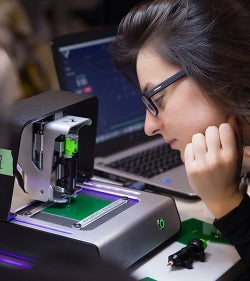
Waterloo invention wins $60K Dyson design award
Voltera’s custom circuit board printer beat teams from 20 countries to become the first Canadian project to win prestigious Dyson Award

Voltera’s custom circuit board printer beat teams from 20 countries to become the first Canadian project to win prestigious Dyson Award
By Carol Truemner Faculty of EngineeringVoltera V-One, a custom circuit board printer developed by University of Waterloo engineering students, has taken top prize in the International James Dyson Award competition - beating out a record 710 entries from 20 countries.
Voltera is the first Canadian team to capture the prestigious award that comes with a prize of about $60,000 (CAD) for the team and $10,000 for the University’s Faculty of Engineering.
“The Voltera V-One team is made up of four impressive young graduates. Their solution makes prototyping electronics easier and more accessible – particularly to students and small businesses. But it also has the potential to inspire many more budding engineers,” said James Dyson, a renowned British inventor whose foundation sponsors the award.
The printer was created by Alroy Almeida, Katarina Ilic, James Pickard, and Jesús Zozaya as their Engineering Capstone Design project. It enables circuit boards to be prototyped within minutes, eliminating the frustrations with traditional fabrication processes and drastically reducing hardware development time.

After graduating in 2013, the team moved Voltera into the Velocity Garage, a University of Waterloo startup incubator. The team moved over to the Velocity Foundry when the University launched its hardware incubator in 2014.
“As a startup, the university's name has opened doors for us on the worldwide stage,” said co-founder Zozaya. “As students, we experienced different industries through the Waterloo co-op program and as employers, we have a constant supply of high-quality students who have proven invaluable to the development of the Voltera V-One."
 While studying mechatronics engineering, Almeida, Zozaya, and Pickard became frustrated by the inefficiency of designing circuit boards. Teaming up with Ilic, who was studying nanotechnology engineering, the students spent two years improving the electrical properties of the conductive nano-silver ink, producing a compact electromechanical system to dispense the thick ink and developing a software algorithm to control it precisely.
While studying mechatronics engineering, Almeida, Zozaya, and Pickard became frustrated by the inefficiency of designing circuit boards. Teaming up with Ilic, who was studying nanotechnology engineering, the students spent two years improving the electrical properties of the conductive nano-silver ink, producing a compact electromechanical system to dispense the thick ink and developing a software algorithm to control it precisely.
The end result — the Voltera V-One printer — was named one of the top 10 innovations for 2015 by Popular Science. It has also been recognized as the 2015 TechCrunch Disrupt (Hardware Battlefield) Champion and this year’s Make Magazine Editor's Choice.
“The Voltera V-One printer pushes the boundaries of innovation,” said Pearl Sullivan, dean of Waterloo Engineering. “It is an excellent example of what our students are capable of when they graduate from Waterloo Engineering. They took a very complex problem and came up with an elegant solution that would change customized circuit printing forever. The future of technology innovation in Canada lies within brilliant teams like Voltera."
The James Dyson Award, launched by the James Dyson Foundation in 2007, is an international student design challenge open to university level students and recent graduates in the fields of product design, industrial design and engineering with the objective to design something that solves a problem.
Suncayr, a Waterloo nanotechnology engineering student startup, was the first runner up in the International James Dyson Award competition last year. Suncayr invented an easy-to-use marker that indicates when sunscreen needs to be reapplied. Also started as a Waterloo Engineering Capstone Design Project, it is now part of the University's Velocity Foundry and Velocity Science startup programs.

Read more
The 2025 cohort represents some of the brightest new entrepreneurial minds in STEM

Read more
GreenHouse awards $10,000 to student ventures and changemakers aiming to transform livelihoods within disadvantaged communities

Read more
Meet the five exceptional graduate students taking the convocation stage as Class of 2024 valedictorians
The University of Waterloo acknowledges that much of our work takes place on the traditional territory of the Neutral, Anishinaabeg, and Haudenosaunee peoples. Our main campus is situated on the Haldimand Tract, the land granted to the Six Nations that includes six miles on each side of the Grand River. Our active work toward reconciliation takes place across our campuses through research, learning, teaching, and community building, and is co-ordinated within the Office of Indigenous Relations.